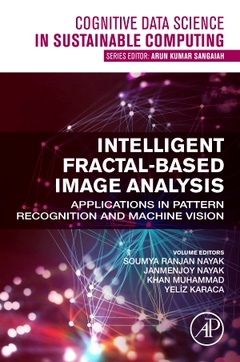Intelligent Fractal-Based Image Analysis Applications in Pattern Recognition and Machine Vision Cognitive Data Science in Sustainable Computing Series
Coordonnateurs : Nayak Soumya Ranjan, Nayak Janmenjoy, Muhammad Khan, Karaca Yeliz

Intelligent Fractal-Based Image Analysis: Application in Pattern Recognition and Machine Vision provides insights into the current strengths and weaknesses of different applications as well as research findings on fractal graphics in engineering and science applications. The book aims to improve the exchange of ideas and coherence between various core computing methods and highlights the relevance of related application areas for advanced as well as novice-user application. The book presents core concepts, methodological aspects, and advanced feature opportunities, focusing on major, real-time applications in engineering and health science. It will appeal to researchers, data scientists, industry professionals, and graduate students. Fractals are infinite, complex patterns used in modeling physical and dynamic systems. Fractal theory research has increased across different fields of applications including engineering science, health science, and social science. Recent literature shows the vital role fractals play in digital image analysis, specifically in biomedical image processing. Fractal graphics is an interdisciplinary field that deals with how computers can be used to gain high-level understanding from digital images. Integrating artificial intelligence with fractal characteristics has resulted in new interdisciplinary research in the fields of pattern recognition and image processing analysis.
Part 1: Intelligent Fractal-Based Image Analysis Introduction to Intelligent Fractal-Based Image Analysis – Editors 1.1 Insights into Intelligent Fractal-Based Image Analysis with Pattern Recognition 1.2 Analysis of Mandelbrot Set Fractal Images Using Machine Learning Based Approach 1.3 Chaos-based Image Encryption1.4 Fractal Feature-based Image Classification Part 2: Recognition Model Using Fractal Features 2.1 The study of Source Image and its Futuristic Quantum Applications: An insight from Fractal Analysis 2.2 Wavelet Multifractal Characterization of Anisotropic Oscillating Singularities and Application in Nanomaterials 2.3 GID-Net: Generic Image Denoising using Convolutional Auto-encoders 2.4 Geometrical Description of Image Analysis Using Fractal Theory Part 3: Fractals in Disease Identification and Control 3.1 Fractal Theory and the Explainable Artificial Intelligence of Cancer Medical Imaging 3.2 Computational Complexity of Multifractal Models-based MRI Image Processing for Subgroups of Multiple Sclerosis Patients’ Diagnosis and Course in Precision Medicine 3.3 AI-Stochastic Fractal Analysis of the Alzheimer disease (AD) Medical Images 3.4 Preliminary Study of Retinal Lesions Classification on Rational Fundus Images for the Diagnosis of Retinal Diseases
Dr. Soumya Ranjan Nayak now holds the position of Assistant Professor in the School of Computer Engineering at Kalinga Institute of Industrial Technology (KIIT) Deemed to be University, located in Odisha, India. He obtained a Doctor of Philosophy (Ph.D) and Master of Technology (M.Tech) in Computer Science and Engineering under a scholarship provided by the Ministry of Human Resource Development (MHRD) of the Government of India. These degrees were earned at CET, BPUT Rourkela, India. Prior to this, he completed a Bachelor of Technology (B. Tech) and a Diploma in Computer Science and Engineering. He has authored over 150 articles that have been published in reputable international journals and conferences such as Elsevier, Springer, World Scientific, IOS Press, Taylor & Francis, Hindawi, Inderscience, IGI Global, and others. These publications have undergone a rigorous peer-review process. In addition to the aforementioned accomplishments, the individual has authored 16 book chapters, published 6 books, and obtained 7 Indian patents (with 4 patents being granted). Furthermore, they have secured 4 International patents, all of which have been granted. The researcher's current areas of focus encompass medical picture analysis and classification, machine learning, deep learning, pattern recognition, fractal graphics, and computer vision. The author's writings have garnered over 1500 citations, with an h-index of 24 and an i10-index of 63, as reported by Google Scholar. Dr. Nayak holds the position of an associate editor for several esteemed academic journals, including the Journal of Electronic Imaging (SPIE), Mathematical Problems in Engineering (Hindawi), Journal of Biomedical Imaging (Hindawi), Applied Computational Intelligence and Soft Computing (Hindawi), and PLOS One. He is currently fulfilling the role of a guest editor for special issues of renowned academic journals such as Springer Nature, Elsevier, and Taylor & Franchise. He has been affiliated as a rev
- Investigates advanced fractal theories spanning neural networks, fuzzy logic, machine learning, deep learning, and hybrid intelligent systems in solving pattern recognition problems
- Explores the application of fractal theories to a wide range of medical image processing modalities
- Presents case studies that illustrate the application and integration of fractal theories into intelligent computing in the resolution of important pattern recognition and machine vision problems
Date de parution : 05-2024
Ouvrage de 318 p.
15x22.8 cm
Thèmes d’Intelligent Fractal-Based Image Analysis :
Mots-clés :
<; p>; Fractal; pattern recognition; machine learning; classification; chaos; medical imaging; object detection; segmentation; remote sensing; texture analysis<; /p>



